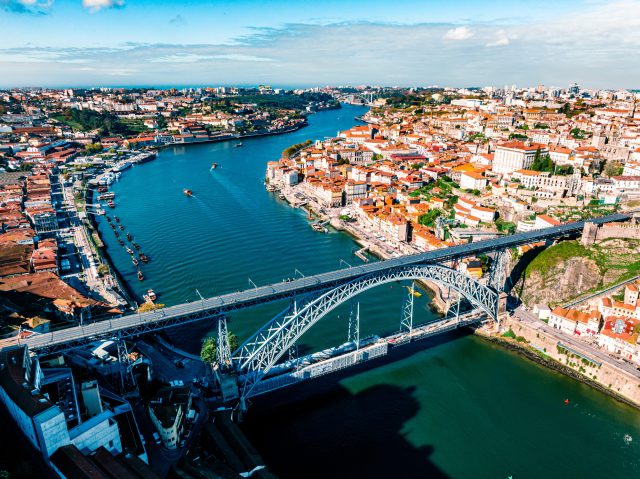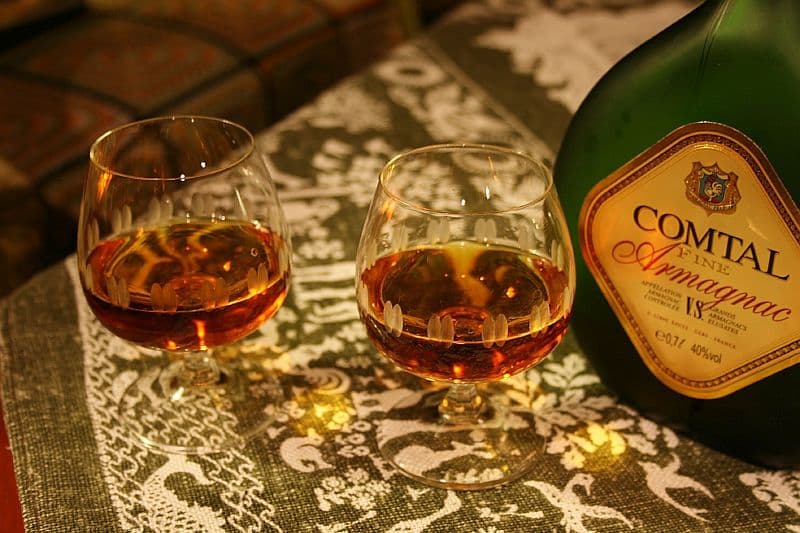Port is a fortified wine born of a trade war in the 17th century between English and French tradesmen. Now, hundreds of years have passed, and Port, like most sweet wine, still appeals only to a relatively small group of wine collectors.
Why the attraction mainly for collectors? Because wine drinkers serious enough to build a collection understand that nearly all Port is to be aged before consumption. Port is not at its best, except for most Ruby, within months of bottling. Indeed, Vintage Port from a declared year, is not ready to drink until it has been in bottle for 20-30 years, or longer if the year was exceptional.
The production of Port begins in the terraced vineyards of the upper Douro Valley. Scattered among the rolling vineyards are estates that ship the new fortified wine down river to aging lodges in Vila Nova de Gaia across the river from Porto.
 | ||||||||
| The Eiffel-designed bridge over the Douro river | |
There are three terms to know that make understanding Port easier. Port is a fortified wine that takes its name from the city of Porto, in northern Portugal. Oporto is English for Porto. Vinho do Porto is the official name for the Portuguese wine.
Officially, Port can be made from a mind-boggling collection of 80 different grapes. In practice, just five varieties are used today by most Port firms, including Touriga Nacional and Tina Roriz (Spain's Tempranillo).
A rapid fermentation is needed to extract maximum color and tannin from the deeply tinted grapes. After two to three days, a fortifying spirit, of at least 70%, with approval of the Institudo dos Vinhos do Douro e do Porto (IVDP), is added to stop the fermentation. Specific styles of Port are then matured in oak barrels for varying times.
Port styles range from young, ready-to-drink, to more complex requiring aging. In general, there are two broad categories. Wood Ports (Ruby and Tawny) are aged mainly in oak barrels, then following filtration, are ready to drink. Bottle aged Ports mature in wood for a short time, then are bottled and are not ready to drink for many years. These are the specific styles.
Ruby is the least expensive and simplest Port, aged in bulk for 2-3 years, then bottled while still ruby in color. Many producers use proprietary names for their Ruby Port. Rubies are grapy, with a rich texture and a hint of spice. A Ruby with more character and depth may be called Reserva. Priced $20 and under.
Tawny is, in theory, a Ruby that has lost its color and is now amber brown. In practice, most Tawny sold today is made from lighter wines and sells for little more than a Ruby. Tawny tastes nutty and lightly caramel. Aged Tawny is a "true" Tawny Port, aged for at least six years in wood and carries an indication of age on the label: 10, 20, up to 50 years. Aged Tawny is a favorite of Port shippers. Price: $25-$30.
Vintage is the most expensive and coveted style of Port. Vintage Port is made only from select ripe grapes grown in the Cima Corgo, northern Douro. When the majority of shippers agree on the quality of a vintage, and the IVDP approves, the year is "declared." Generally, only three years in 10 are declared a vintage. So far this century, these are declared vintages: 2000, 2003, 2007, 2011, 2016, 2017. The 2017 Quinta do Vesuvio, is $85 and Graham's 1977 is $150. Quantity made of a Vintage Port and demand set a premium price for a Vintage Port.
Late Bottled Vintage is a Port bottled between the fourth and sixth years after harvest. Better LBVs are unfined and unfiltered, thus require decanting, like a Vintage. The most common LBVs are fined and sometimes filtered and are ready to drink sooner than a Vintage Port. Many LBVs are $50 or less.
There are two more styles most often seen in wine shops specializing in fortified wines. Garrafeira means "reserve" and comes from a single year and must be aged a minimum of seven years in glass demijohns. Colheita is a Tawny Port from a single year with the date of harvest on the label. By law, a Colheita must be aged in wood for at least seven years.
Praise for Port
For a drink as revered and enjoyed by so many people, there is a surprising dearth of quotable praise for Port. But, I did find these tributes.
H. Warner Allen, early 20th century English journalist mused: "Port is essentially the wine of philosophical contemplation."
A more commonplace view of Port is this often heard paean, "Any port in the storm." The idiom is not attributed to any one person, but is thought to describe a nautical term for sailors needing shelter, going back to at least 1749. Nevertheless, the idiom is applied often to the wine.
If the enjoyment of sipping a well-aged Port gets a little out of hand, try this "hair of the dog that bit you" remedy: melt butter over hot water, stir in a dessertspoon of Worcestershire sauce, the same quantity of orange juice, a pinch of cayenne, and about half a wineglass of old port. Take some freshly browned toast and soak in the mixture before eating. The concoction is known as the "Coalman," presumably referring to the man who worked in a coal mine, or maybe the guy who once delivered coal to your house.
Port and Food
Finally, a few words about Port with food. Ruby and Tawny with no age are best as aperitif drinks. Favorite dishes with Port include créme brulée and chocolate truffles and simple hors d'oeuvres or fresh fruit.
Vintage and those Ports with vintage character, are best on their own, or maybe with a piece of cheese and some lightly salted walnuts or Spanish Marcona almonds. An English tradition is to marry Stilton cheese and Port. Some misguided folks have been known to hollow out a large wheel of Stilton and fill the cavity with Port.
A more sensible person would pour a few ounces of Port into a tulip-shaped glass and enjoy it with a bit of Stilton or any veined cheese.
Happy New Year everyone.
Next post: Los Carneros
Leave a comment at boydvino707@gmail.com













